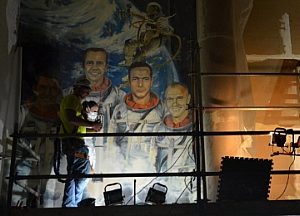 Preserving a piece of NAS Patuxent River’s history, conservators removed a 12-by-20 mural of astronauts Wally Schirra, Alan Shepard, Scott Carpenter and John Glenn from the wall above the doorway of the abandoned Officers Club – or O-Club – located at Pax River on Cedar Point Road across the street from the Chesapeake Bay.
Preserving a piece of NAS Patuxent River’s history, conservators removed a 12-by-20 mural of astronauts Wally Schirra, Alan Shepard, Scott Carpenter and John Glenn from the wall above the doorway of the abandoned Officers Club – or O-Club – located at Pax River on Cedar Point Road across the street from the Chesapeake Bay.
Painted in oil on linen canvas and dedicated in 1986, the large mural, titled “Naval Aviation in Space,” was created by artist George McWilliams during the time he was employed at Pax River from 1981-1987 as a draftsman/illustrator.
“It commemorates the early astronauts trained here at the Test Pilot School,” said Mike Smolek, Pax River’s cultural resources manager. “McWilliams eventually left Pax River to become a fulltime painter and muralist and this was one of his first major murals.”
Smolek explained that the O-Club was a popular assembly space for not only base gatherings but community functions as well, when the base was still accessible to the public.
“It was a large social venue in St. Mary’s County for a long time,” he added. “Organizations held special dinners and events there and even proms were held there. Thousands of people have seen the mural over the years as they left the building. It represents Pax River’s role in national history and emphasizes the significance of what is done here. The Maryland Historical Trust considers it of intrinsic historical value to the base.”
With the building slated for demolition, saving the mural became a priority.
The mural was removed, stabilized and placed it into storage with the eventual goal of having it put on display at the Patuxent River Naval Air Museum (PRNAM).
“Ownership will be taken over by the National Naval Aviation Museum in Pensacola, Florida, which is part of the Naval History and Heritage Command,” Smolek said. “Because it’s a heritage asset, however, the painting will not physically leave the area. It’ll be formally loaned to the [PRNAM] and exhibited.”
Prior to removal, conservators cleaned the surface to remove the majority of grime and soiling from the painting’s surface and applied a protective consolidating facing.
“It’s a spun bound tissue that’s put on with an easily reversible adhesive,” explained David Olin, chief conservator and owner of Olin Conservation Inc. “That gives some stability to the paint layers should the process of removing the canvas cause any disruption. The protective consolidating facing holds the paint so it’s not lost.”
Since a strong adhesive was originally used to bind the painting to the wall, the mural was removed mechanically – meaning no solvents were used and nothing was dissolved – by shearing off the drywall paper to which the canvas was still attached and rolling it face-in onto a tube, which was a quicker and less stressful manner of removal.
Once down from the wall, the conservators unrolled the mural to expose the back and do additional work to prepare it for interim storage and further conservation, then rolled it again face-out, which is the proper way to store it. Eventually, any remaining paper backing and original adhesive will need to be completely removed.
“The pH of the original wall substrate, as well as mold which had developed in the support layers, had damaged the canvas and was beginning to undermine the bond of the paint,” Olin said. “With the ultimate goal being to install a new support to the mural for exhibit purposes in a new venue, any material remaining in the back of the canvas would be damaging and make for a non-uniform installation. It will need to be removed to expose the original canvas and allow for long-term consolidation and re-installation of the mural.”
The mural had been hanging in the empty building for a number of years, but managed to weather the adverse conditions.
“The corner above Schirra was a little more damaged and the canvas there is a little weaker and more rotted from moisture damage but, relatively speaking, the mural is in fair condition and the paint is quite stable,” Olin said.
As an artist, McWilliams was primarily known for his maritime works in watercolor and pencil, as well as scenes of rural countryside, no doubt reflective of his experience growing up in Southern Maryland. Another of his local murals can be found hanging in the St. Clement’s Island-Potomac River Museum in Coltons Point, Maryland. Unveiled in 1999, that 7 by 20 mural depicts the landing at St. Clement’s Island by English colonists in 1634 and features Father Andrew White, the Jesuit priest who established the first missions in St. Mary’s County.
In an April 26, 2015 Facebook post, McWilliams referenced the Pax River mural, writing “it was challenging, but one of the coolest jobs I ever had the opportunity to work on.”
Currently, the mural is at PRNAM where it will be stored in the museum’s new curatorial facility until funds can be secured to complete its conservation.
“A number of people at Pax and the museum worked hard to keep it from being demolished with the building,” Smolek said. “It’s been salvaged, but we still have a way to go before the mural can once again be exhibited.”
For more information, visit www.navy.mil, www.facebook.com/usnavy, or www.twitter.com/usnavy.
For more news from Naval Air Station Patuxent River, visit www.navy.mil/local/patuxent/.


